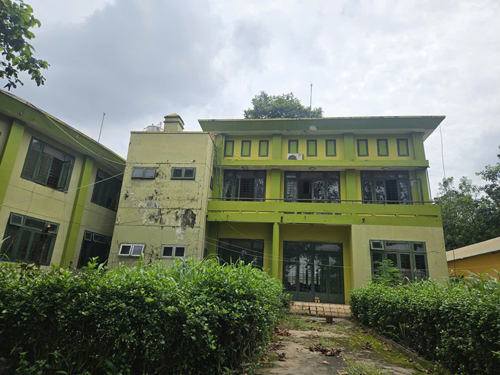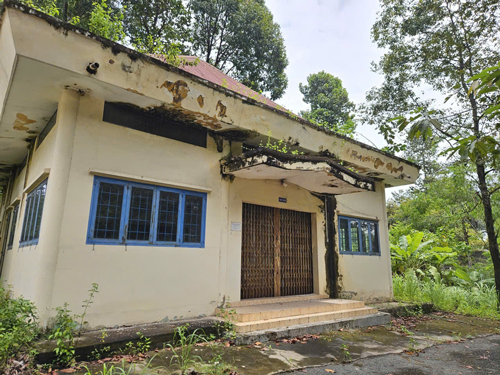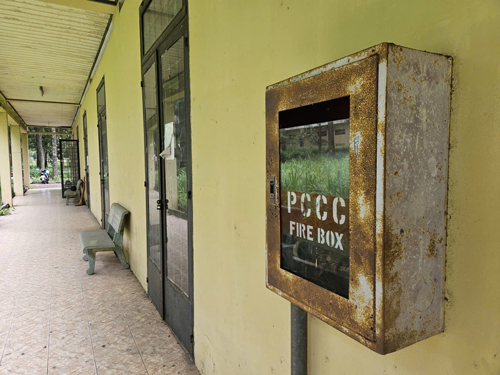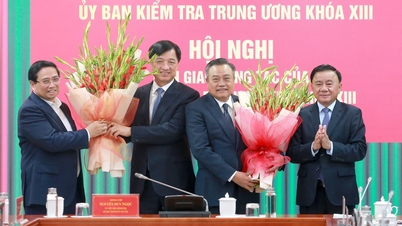Once a prestigious vocational school, the dormitory was always full of people, but now, the Ho Chi Minh City Agricultural Technical College with 13 hectares of land is almost abandoned. It is worth mentioning that in the recent enrollment period, the school only recruited 34 students for the veterinary animal husbandry major.
12 years without buying equipment
Speaking to a reporter from the Lao Dong Newspaper, MSc. Luong The Phuc, Vice Principal in charge of the Ho Chi Minh City Agricultural Technical College, said he had been in charge of the school for 14 months. However, the sad thing is that he has not been able to revive the entire school system.

The library, classrooms, workshops, etc. at the Ho Chi Minh City Agricultural Technical College are abandoned and increasingly degraded.
"On the day I received my new assignment, I opened the school's asset list to check and was shocked. For the past 12 years, the school has not purchased any new equipment or learning tools for students. Meanwhile, the most important vocational training program is practice equipment" - Master Phuc sadly said.
Ho Chi Minh City Agricultural Technical College was formerly the Agricultural Technical High School, based on the merger of the Agricultural High School and the Fisheries Technical Workers School. Up to now, the school has existed for nearly 50 years.


The period when Ho Chi Minh City Agricultural Technical College recruited students most effectively was in the 2000s. At that time, each year the school had over 3,000 students studying at the intermediate level and about 1,000 students studying at the elementary level and short-term certificates; the dormitory with over 500 beds was always full. Although it provided intermediate training, with the advantage of specializing in agriculture, Ho Chi Minh City Agricultural Technical College developed significantly compared to other vocational schools in the same area.
However, in recent years, the Ho Chi Minh City Agricultural Technical College has been "shelved". Both training facilities located on prime land in District 1 and Thu Duc City have been deserted. Nearly 30 classrooms have been locked, and the dormitory is free but has only two students.
Ho Chi Minh City Agricultural Technical College trains 12 majors, but in 2025, it will only recruit 34 students for the veterinary and animal husbandry major. Regarding human resources, from 78 staff and lecturers, the school now has only 20 people remaining.
MSc. Luong The Phuc said that previously, the Ho Chi Minh City Agricultural Technical College mainly focused on short-term and long-term training courses in the provinces, not paying attention to investing in learning facilities at the school. On the other hand, the school was also passive due to the change of state management agencies. Accordingly, before March 1, 2025, the school operated under the management of the Department of Agriculture and Rural Development of Ho Chi Minh City. From March 1 to June 27, 2025, the school waited for documents from competent authorities on organization and arrangement of apparatus.
Teaching and working part-time
In fact, in Ho Chi Minh City, there are still many vocational schools facing difficulties in many aspects, such as sparse enrollment, lack of equipment, insufficient space, degraded facilities, etc. Even more sadly, many teachers are owed salaries and have to work part-time jobs to try to make ends meet.
Sharing with reporters, Ms. Phan Thi Ngoc Suong, a teacher at Binh Thanh Vocational College, sadly said that after many petitions, the school still owes 2 months of salary (August and September 2025). There was even a time when the school was more than half a year late in paying teachers' salaries.
On Ms. Suong's Vietnam Social Security Digital (VssID) application, her account has been 15 months late in paying social insurance, 8 months late in paying unemployment insurance, and health insurance has been suspended since April 16, 2025. In addition, other amounts such as additional income, overtime teaching, exam grading/invigilation work... are also "lying still".
Ms. Suong emphasized: "I have worked at this school for nearly 20 years. If I did not love my job and my students, I probably would not have stayed until now. Being a teacher is difficult, being a vocational education teacher is even more difficult. The school and relevant agencies need to quickly resolve this situation. Only then can we feel secure in our work."
MSc. Nguyen Ngoc Bao Chuong, Principal of Binh Thanh Vocational College, explained that the school's salary and insurance arrears stemmed from a prolonged financial imbalance. "The school is a second-class financial autonomy unit, which means it is guaranteed 100% regular spending. In April 2022, when I took over the job, the school was already in a negative fund. The school owed both teachers' salaries and the state about 65 billion VND. To maintain operations, the school was forced to spend on overhead, which means using the tuition fees of the next term to pay the fees of the previous term," said MSc. Chuong.
Currently, Binh Thanh Vocational College has only one source of income from the secondary level compensation according to Decree 81/2021. However, the number of students decreases every year. In the 2025-2026 school year, the school can only recruit 46/315 targets.
"The school is completing the tuition fee records for the first semester of the 2025-2026 school year. It is expected that in November 2025, the school will receive this funding and continue to pay teachers' salaries" - Master Chuong said cautiously.
The distance is too great
At the conference to summarize the 2024-2025 school year and deploy tasks for the 2025-2026 school year for vocational education and continuing education in Ho Chi Minh City, a representative of Phuoc Loc Technical and Technology College affirmed that although there are enough practice workshops, the shortage and outdated machinery and equipment are creating a huge gap between training and production practice. This is a difficult problem due to high investment costs and lack of sponsorship from businesses.
The distribution of vocational education network is uneven, mainly concentrated in urban areas and limited in land area at many facilities, reducing the ability to expand the scale. The number of vocational schools that enroll enough students is very small compared to the general level of Ho Chi Minh City. Most schools have to "struggle" to maintain operations.
According to MSc. Nguyen Minh Quang, Vice Principal of Ho Chi Minh City Electricity College, in recent years, vocational education recruitment has been very difficult, with many influencing factors. Firstly, salary policies in many units and enterprises still give priority to people with university degrees; salary payment according to job position has not been widely implemented.
Second, the social psychology still favors degrees. Third, the university admission policy creates many opportunities for candidates to study at university. Fourth, the resources of vocational training institutions are not strong enough to compete, especially in terms of financial resources for investment and development.
"Vocational training institutions focus on vocational skills training, have large investment costs for equipment, and find it difficult to recover capital without state support," said Master Quang.
(To be continued)
Reorganizing the vocational education network
Statistics from the Department of Continuing Education - Vocational and University, Department of Education and Training of Ho Chi Minh City show that the city has 481 vocational training establishments. Of which, the public sector has 104 units, the remaining are 377 non-public establishments. Currently, the scale of vocational training in the area reaches about 327,000 learners.
According to the draft guidelines for implementing the tasks of the 2025-2026 school year for vocational education, Ho Chi Minh City will continue to implement the project to rearrange the system of public colleges and intermediate schools in the period 2025-2030. The rearrangement aims to reorganize the network of vocational education facilities in a streamlined and reasonably distributed manner, meeting the requirements of socio-economic development and in line with the 2-level local government model.
Source: https://nld.com.vn/truong-nghe-hoang-tan-no-luong-trien-mien-196251106210811231.htm







![[Photo] Da Nang: Hundreds of people join hands to clean up a vital tourist route after storm No. 13](https://vphoto.vietnam.vn/thumb/1200x675/vietnam/resource/IMAGE/2025/11/07/1762491638903_image-3-1353-jpg.webp)
































































































Comment (0)